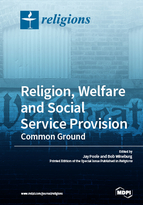Religion, Welfare and Social Service Provision: Common Ground
A special issue of Religions (ISSN 2077-1444).
Deadline for manuscript submissions: closed (15 March 2016) | Viewed by 96273
Special Issue Editors
Interests: religious service; social welfare community service; social program development; community partnerships; coalitions; policy
2. The Joint Programs in Social Work with UNCG and North Carolina Agricultural and Technical State University (NCA&T SU), Greensboro, NC 27421, USA
Interests: community-engaged health care; social welfare services
Special Issues, Collections and Topics in MDPI journals
Special Issue Information
Dear Colleagues,
For the last two decades from 30,000 feet, the average person and the distant scholar would think that religion’s contribution to public life has been embodied by a shadow boxing of sorts between the right and left. Such a broad stroke does make for good news, debate, and discussion, but does not capture the thousands, if not hundreds of thousands partnerships among religious communities, government, nonprofits, to fill the gaps mostly created by a world-wide shrinking of the “welfare state” and aimed at the “public good.” We are calling for papers that capture how houses of worship at the ground level, are increasingly “houses of service.” Papers in this Special Issue will be focused on building a better understanding of the intersection of general welfare policy, religion, and religion and service as it takes shape in the voluntary actions of the religious community.
The overall focus will be on assembling, in one volume, perhaps the first set of what may become seminal articles that cross “disciplinary boundaries” and address what is in the world at the intersection of religion, public health, social work, human services, theology, nonprofit management, medicine, community psychology, theology, and other theoretical and especially professional service fields by defining and exploring how and why partnerships work or don’t work in reality. A broad and long term goal of the volume would be to begin developing scholarship that better shapes best practices where the intersection of religion, welfare, and service converge.
Prof. Dr. Robert Wineburg
Guest Editor
Manuscript Submission Information
Manuscripts should be submitted online at www.mdpi.com by registering and logging in to this website. Once you are registered, click here to go to the submission form. Manuscripts can be submitted until the deadline. All papers will be peer-reviewed. Accepted papers will be published continuously in the journal (as soon as accepted) and will be listed together on the special issue website. Research articles, review articles as well as short communications are invited. For planned papers, a title and short abstract (about 100 words) can be sent to the Editorial Office for announcement on this website.
Submitted manuscripts should not have been published previously, nor be under consideration for publication elsewhere (except conference proceedings papers). All manuscripts are thoroughly refereed through a double-blind peer-review process. A guide for authors and other relevant information for submission of manuscripts is available on the Instructions for Authors page. Religions is an international peer-reviewed open access monthly journal published by MDPI.
Please visit the Instructions for Authors page before submitting a manuscript. Submitted papers should be well formatted and use good English. Authors may use MDPI's English editing service prior to publication or during author revisions.
Keywords
- Community Partnerships
- faith-based social/health/behavioral health service collaboration
- Faith and service
- Government by proxy
- inter-faith coalitions
- community ministry
- professional and lay partnerships
- health in place






